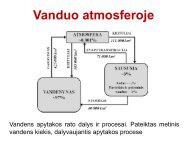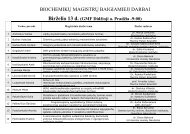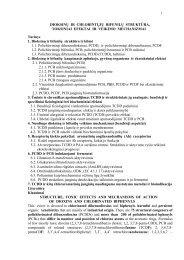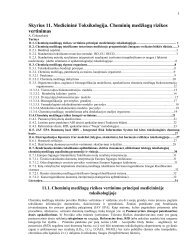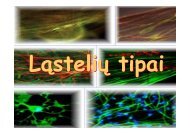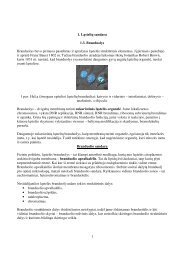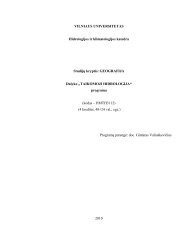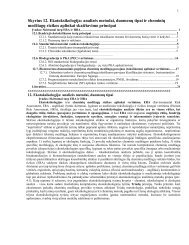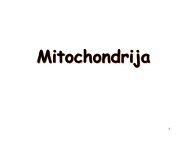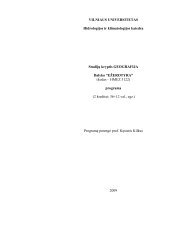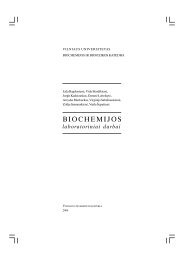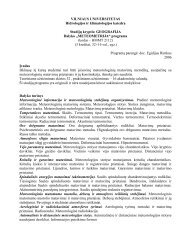Species and Their Formation - Laboratory of Visual Systems
Species and Their Formation - Laboratory of Visual Systems
Species and Their Formation - Laboratory of Visual Systems
Create successful ePaper yourself
Turn your PDF publications into a flip-book with our unique Google optimized e-Paper software.
494 CHAPTER TWENTY-FOURswords have differentiated very little in their chloroplastgenes.The isl<strong>and</strong> silverswords are more diverse in size <strong>and</strong>shape than the mainl<strong>and</strong> tarweeds because the original colonizersarrived on isl<strong>and</strong>s that had very few plant species. Inparticular, there were few trees <strong>and</strong> shrubs, because suchlarge-seeded plants rarely disperse to oceanic isl<strong>and</strong>s. In fact,many isl<strong>and</strong> trees <strong>and</strong> shrubs have evolved from nonwoodyancestors. On the mainl<strong>and</strong>, however, tarweeds live in ecologicalcommunities that contain tree <strong>and</strong> shrub lineagesolder than their own—that is, where opportunities to exploitthe “tree” way <strong>of</strong> life have already been preempted.The processes we have discussed in this chapter, operatingover billions <strong>of</strong> years, have produced a world in which life isorganized into millions <strong>of</strong> species, each adapted to live in aparticular environment <strong>and</strong> to use environmental resourcesin a particular way. How these millions <strong>of</strong> species are distributedover the surface <strong>of</strong> Earth <strong>and</strong> organized into ecologicalcommunities will be a major focus <strong>of</strong> Part Eight <strong>of</strong> this book.Chapter SummaryWhat Are <strong>Species</strong>? <strong>Species</strong> are independent evolutionary units. A commonlyaccepted definition <strong>of</strong> species is “groups <strong>of</strong> actually or potentiallyinterbreeding natural populations which are reproductivelyisolated from other such groups.” Because speciation is <strong>of</strong>ten a gradual process, it may be difficultto recognize boundaries between species. Review Figure 24.3How Do New <strong>Species</strong> Arise? Not all evolutionary changes result in new species. Allopatric (geographic) speciation is the most importantmode <strong>of</strong> speciation among animals <strong>and</strong> is common in othergroups <strong>of</strong> organisms. Review Figures 24.4, 24.5, 24.6.See Web/CD Tutorial 24.2 Sympatric speciation may occur rapidly by polyploidybecause polyploid <strong>of</strong>fspring are sterile in crosses with members<strong>of</strong> the parent species. Polyploidy is a major factor in plant speciationbut is rare among animals. Review Figures 24.7, 24.8See Web/CD Tutorial 24.1Completing Speciation: Reproductive IsolatingMechanisms Once two populations have been separated, reproductive isolatingmechanisms may prevent the exchange <strong>of</strong> genes betweenthem. Prezygotic reproductive barriers operate before fertilization.Some prezygotic barriers affect mate choice; others work byinfluencing pollinator behavior. Review Figure 24.10, 24.11 Postzygotic reproductive barriers operate after fertilization byreducing the survival or fertility <strong>of</strong> hybrid <strong>of</strong>fspring. If hybrid <strong>of</strong>fspring survive poorly, more effective prezygoticreproductive barriers may evolve. This process is known asreinforcement. Review Figure 24.12Hybrid Zones: Incomplete Reproductive Isolation Hybrid zones may develop if barriers to gene exchange fail todevelop while diverging species are isolated from each other.Review Figure 24.13 <strong>Species</strong> may differ from one another in very few genes.Variation in Speciation Rates Rates <strong>of</strong> speciation differ greatly among lineages. Speciationrates are influenced by the number <strong>of</strong> species in a lineage, theirdispersal rates, ecological specialization, experience <strong>of</strong> populationbottlenecks, pollinators, <strong>and</strong> behavior, as well as by climaticchanges.Evolutionary Radiations Evolutionary radiations occur when speciation rates exceedextinction rates. High speciation rates <strong>of</strong>ten coincide with low extinction rateswhen species invade isl<strong>and</strong>s or other environments that containfew other species. As a result <strong>of</strong> speciation, Earth is populated with millions <strong>of</strong>species, each adapted to live in a particular environment <strong>and</strong> touse resources in a particular way.See Web/CD Activity 24.1 for a concept review <strong>of</strong> this chapter.Self-Quiz1. A species is a group <strong>of</strong>a. actually interbreeding natural populations that arereproductively isolated from other such groups.b. potentially interbreeding natural populations that arereproductively isolated from other such groups.c. actually or potentially interbreeding natural populationsthat are reproductively isolated from other such groups.d. actually or potentially interbreeding natural populationsthat are reproductively connected to other such groups.e. actually interbreeding natural populations that arereproductively connected to other such groups.2. Allopatric speciation may happen whena. continents drift apart <strong>and</strong> separate previously connectedlineages.b. a mountain range separates formerly connected populations.c. different environments on two sides <strong>of</strong> a barrier causepopulations to diverge.d. the range <strong>of</strong> a species is separated by loss <strong>of</strong> intermediatehabitat.e. all <strong>of</strong> the above3. Finches speciated in the Galápagos Isl<strong>and</strong>s becausea. the Galápagos Isl<strong>and</strong>s are not far from the mainl<strong>and</strong>.b. the Galápagos Isl<strong>and</strong>s are arid.c. the Galápagos Isl<strong>and</strong>s are small.d. the isl<strong>and</strong>s <strong>of</strong> the Galápagos Archipelago are sufficientlyisolated from one another that there is little migrationamong them.e. the isl<strong>and</strong>s <strong>of</strong> the Galápagos Archipelago are closeenough to one another that there is considerablemigration among them.4. Which <strong>of</strong> the following is not a potential prezygoticreproductive barrier?a. Temporal segregation <strong>of</strong> breeding seasonsb. Differences in chemicals that attract matesc. Hybrid infertilityd. Spatial segregation <strong>of</strong> mating sitese. Sperm cannot survive in female reproductive tracts



